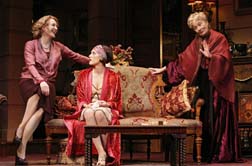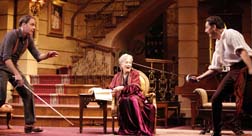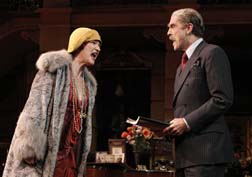By Lucy Komisar
If there’s a king and queen in this production of The Royal Family, the George S. Kaufman-Edna Ferber 1927 parody of the Barrymore acting dynasty, they are Jan Maxwell and Reg Rogers, who steal the show with their theatricality.

The device of the play is that Julie Cavendish (Maxwell) and her daughter Gwen (Kelli Barrett) are torn between their love of the stage and their desire to have married lives. Julie’s mother Fanny (Rosemary Harris), the grande dame of the family, revels in having had both.
The beaux, a controlling multimillionaire rancher and mine owner (Larry Pine) in Julie’s case and a well-off stockbroker (Freddy Arsenault) in Gwen’s, have more traditional life styles in mind. Playing out the conflict gives everyone in the stage family the chance to sigh and emote about the glories of life on the boards. The text is dated. Well, this play is more than 80 years old!
Director Doug Hughes is fortunate to have Maxwell, who positively dances when she walks; she sparkles, she flirts. Am I center? she asks as she’s about to address the family. Her I am never going to act again is as front and center as any actress would want. As a stand-in for the premi¨re Ethel Barrymore, she is more kittenish than I would have expected, and Ethel at the time wrote her displeasure at the portrayal.

Rogers as her brother Tony, the John Barrymore character, is theatrical in every muscle, with a plosive speech and charm that make the stage light up when he is on. He conjures up the swashbuckling John in a sword play with Julie’s trainer (Rufus Collins). If Tony is supposed to be a drinker and womanizer, he comes across more as a playful puppy.
Rosemary Harris is the sentimental favorite as Fanny. Her dramatic paean to the theater is a gem. Barret is sweet as the ingénue, though her spirit seems more modern than 1920s. The two represent the beginning and the end. Gwen delights at the prospect of being a star, and Fanny won’t recognize that she is too ill to go on the road.

All that said, Hughes’ revival occasionally falls flat. The production starts especially slow in the first scene of phones ringing and servants running, though the pace picks up. Fanny’s brother Bertie (John Glover) and his wife Kitty (a too shrill Ana Gasteyer), are rather grating as they fight with each other and try to promote their waning talents. Casting a fey David Greenspan as the butler was an egregiously wrong choice, hardly the properly regal servant this caviar-eating family of that era would have.
What passed for wit and charm then doesn’t always make it now. Julie jokes about the author of her new play, who they are going to meet, that if he’s English, he’ll probably be lecturing the next day. Quaint. A throwaway remark about Little Lord Fauntleroy does not spark recognition. It made more sense in 1927.
John Lea Beatty has created a stunning set: damask covered French style furniture, a gold wrought iron balustrade going up the stairs, cream pillars, miniature knights in armor, over the fireplace a painting of a Shakespearean actor who turns out to be Fanny’s late husband. Indeed, they are the touches of royalty.
In the end, the actors pull it off, proving that when fine players such as these, in the tradition of the Barrymores, take to the stage, they are a delight to behold.
The Royal Family. Samuel J. Friedman Theatre, 261 West 47th Street, New York City. Written by George S. Kaufman & Edna Ferber; Directed by Doug Hughes. 212-239-6200. Opened October 8, 2009, Closes December 13, 2009.

